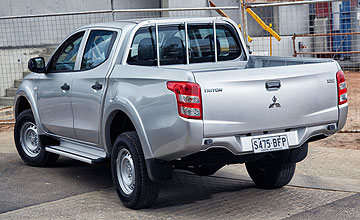BY TIM ROBSON | 28th Apr 2015

A pair of steel beams, a body, some drivetrain bits and an engine… and that’s pretty much all there is to it.
For many reasons, the dual-cab ute has become the darling of the car market – and it’s pretty popular in the boardroom, too, thanks to its low cost of manufacture.
Gone are the days when buyers were happy to accept a rough and ready device that is one step removed from a mine site or farmer’s paddock. The dual-cab ute has had to play catch-up pretty quickly, and provide levels of comfort, physical and aural ride quality and value that it simply didn’t need to do a decade ago.
The MN Triton has sold more than 150,000 units in its eight years on sale, and even tody sits in the top three of its category behind the Toyota HiLux and Ford Ranger.
Finishing third in the 4x4 pick-up segment in 2014 with 19,990 cars (behind Ford Ranger and Toyota HiLux), it currently sits second for the year to date (4947) behind Toyota’s resurgent pick-up (6047) and a whisker in front of the Ranger (4932).
And while it’s still not a bad rig by most modern comparisons, Mitsubishi saw the need to bring the Triton deep into the 21st century.
Key to its game plan is the Triton’s five-star ANCAP crash safety rating, awarded to all variants. The company has been missing in action from fleets such as mining companies that require a maximum five-star rating for the last couple of years, but it’s now able to move back into that arena.
The company also took the opportunity to adjust the nomenclature of the range to fit better with the rest of its SUV line-up – a tip that others in the game might be wise to adapt.
There are eleven variants on offer, split between three grades. The GLX is aimed at primary industry and government fleets, the GLS is tilted at the private buyer, while the Exceed nameplate – pinched from the Pajero line-up, amongst others – tops the tree with a full-fruit offering.
While it’s not quite true to say that the Triton is a ground-up, 100 per cent new vehicle, it’s pretty close. More than 80 per cent of the body and 40 per cent of the chassis is completely new, while the leftover bits – including the suspension and steering – have been completely overhauledTaking a starring role is an all-new diesel engine that sports as much tech as Mitsubishi makes. Making its debut in the Triton, the 4N15 is a 2.4-litre diesel four-potter that features an ultra low compression ratio of 15:1, MIVEC valve timing, a lightweight variable geometry turbo and more.
Built on a new, all-alloy block and running a timing chain that replaces the previous Triton’s belt arrangement (it’ll never need changing, according to Mitsubishi), the engine makes 133kW at 3500rpm and 430Nm at 2500rpm – 2kW and up to 80Nm more than previously.
Fuel economy figures range between 7.2 litres per 100 kilometres (GLX dual-cab manual) and 7.6L/100km (Exceed automatic).
Transmissions are new, too a tweaked version of the five-speed Aisin auto from Pajero is pressed into service, while a new heavy-duty six-speed manual also makes its Mitsubishi debut in the Triton.
The suspension has been overhauled front to back, four-wheel drive systems have been updated, all body panels are new… but what isn’t as obvious is the way that these changes have been blended together.
In short, the new-generation Triton is a revelation. The new diesel engine is a terrific piece of kit, belying its capacity to propel 1800-odd kilograms of truck up hill and down dale.
Mitsubishi engineers spent time in Australia with final production prototypes, building in better throttle response and improved high-speed loose surface stability into the Triton before launch, and it shows. Response underfoot is measured and prompt, with little lag in evidence.
Both transmissions work well with the new engine, too, while the revised Easy Select 4WD system in the base GLX and the Super Select 4WD II system for GLS and Exceed do their jobs without fuss. The Triton is actually the only 4x4 ute that can be driven on the road in what is essentially all-wheel-drive mode that is, without the involvement of a centre diff.
Our 300km test in an automatic GLS dual-cab style-side ute reveals an easy-to-live-with personality, a settled, dynamic ride quality even when unladen, and truly low levels of noise intrusion from either the engine or the tyres.
The made-over interior is still simple and functional, while the MQ Triton’s new front seats are a vast improvement over the MN’s pews.
There’s no doubt that 4x4 ute customers are still on the receiving end of a commercial vehicle mindset, though, with very few extra mod cons included in the ticket price.
There’s but a single USB port, for example, no rear vents, satellite navigation and smart keys are reserved for the range-topping Exceed… with buyers increasingly voting with their dollars for fully-optioned rigs, throwing a few more bones to the mid-spec GLS would not hurt sales.
On balance, though, Mitsubishi moves into a new era of competition in the 4x4 pick-up space with a serious contender. It’ll be watching what Ford and Toyota does with interest, but Mitsubishi’s Triton is a worthy contender in the battle that’s to come.